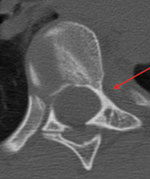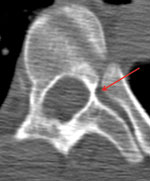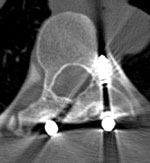Frequency of abnormal pedicles highest in the thoracic spine and in patients with adolescent idiopathic scoliosis
 Adam L. Wollowick |
ORLANDO, Fla. — With significant risks associated with misplaced pedicle screws, researchers who studied the prevalence of abnormal pedicles in the spine found this abnormality occurred in 10% of normal patients and 20% of patients with adolescent idiopathic scoliosis leading to a threefold higher rate of pedicle screw misplacement.
“A firm understanding of pedicle morphology is critical for accurate screw placement,” particularly in individuals with adolescent idiopathic scoliosis (AIS) who present with more abnormal pedicles, Adam L. Wollowick, MD, of the Albert Einstein College of Medicine and Montefiore Medical Center in Bronx, N.Y., said at the 2010 Annual Meeting of the North American Spine Society.
Wollowick and colleagues, including senior author Vishal Sarwahi, MD, retrospectively analyzed a group of 95 healthy patients and a group of 99 patients with AIS who underwent posterior spinal fusion by reviewing preoperative CT scans and grading their imaged pedicles. Both groups were fairly similar except there were more women in the AIS group as might be expected, Wollowick said.
Objective pedicle ratings
To rank the 6,370 pedicles they analyzed, investigators used a modified, objective version of a subjective intraoperative classification developed by Kei Watanabe, MD, and Lawrence G. Lenke, MD, in which pedicles are rated A if they have a channel greater than 4 mm in diameter (normal), B if the channel is 2 mm to 4 mm, or C if the channel is purely cortical. In D-rated pedicles, the channel is either nonexistent or is less than 2 mm in diameter.
|
|
|
Images: Wollowick AL |
“In the patients [with normal spines] about 10% of pedicles were abnormal. This was a surprisingly high finding,” Wollowick said, noting 20% in the AIS group had abnormal pedicles and twice as many B and C type pedicles as the normal subjects. Normal subjects had almost no Type D pedicles.
Thoracic pedicles
When the researchers studied the location of abnormal pedicles in both groups nearly all of them were found in the thoracic spine, with 94% in the normal group and 97% in the AIS group located there.
“Most of the abnormal pedicles occurred in the upper thoracic region,” Wollowick added.
According to the study, in patients with AIS, one in three pedicles in the upper thoracic region was abnormal.
Based on an analysis of postoperative CT scans of 68 patients with AIS treated with pedicle screws, 93% of screws were properly placed in normal pedicles compared with 78% proper placement in abnormal pedicles, “indicating a threefold increase in misplacement,” Wollowick said.
There was also a correlation seen between abnormal pedicles and location on the concavity of the curve and in the periapical region. – by Susan M. Rapp
Reference:
- Wollowick AL, Sugarman E, Nirenstein L, et al. Incidence, distribution and surgical relevance of abnormal pedicles in normal and deformed spines: A CT based study of 6,256 pedicles. Paper #7. Presented at the 2010 Annual Meeting of the North American Spine Society. Oct. 5-9, 2010. Orlando, Fla.
- Adam L. Wollowick MD, can be reached in the Department of Orthopaedic Surgery, 3400 Bainbridge Ave. 6th Floor, Bronx, NY 10467; 718-920-5376; e-mail: adwollow@montefiore.org.
- Disclosure: Wollowick’s institution receives research support from DePuy Spine, K2M and Stryker Spine.
Pedicle-based fixation is the mainstay of spinal fixation for degenerative conditions, trauma, tumor, and deformity. There is significant variability in the size and morphology of pedicles in the lumbar and thoracic spine, and this variability has been detailed in cadaveric and radiographic studies including work by Ebraheim and Parent. Wantanabe, Lenke and colleagues introduced a novel classification of pedicle morphometry based upon the size of the cancellous channel.
Wollowick and colleagues used the Wantanabe and Lenke classification to define the frequency and location of abnormal pedicles (Lenke B, C, D) in normal and scoliotic spines. The study demonstrates that pedicle morphology is most likely to be abnormal in the upper thoracic spine, with scoliotic spine being twice as likely to have abnormal morphology. The findings are important in alerting the surgeon to be especially aware of variance in the upper thoracic spine for surgical planning. The authors demonstrated a significantly higher rate of misplaced screws in abnormal pedicles, and this may have important implications for rigidity of fixation and complications of surgery. The use of image guidance may be more useful in the upper thoracic spine of patients with scoliosis than in other regions of the spine. In light of a relatively high incidence of abnormal pedicles in spines with and without deformity, it is important for the surgeon to have alternative techniques of fixation available for pedicles that are not safely instrumented. These alternatives may include hooks, wires, or no fixation. Future research may include localization of abnormal pedicles on the concavity or convexity of the deformity, and plain X-ray findings that may correlate with abnormal pedicle morphology.
— Sigurd H. Berven, MD
Orthopedics
Today Editorial Board member
Director of Spine Fellowship and
Resident Education Department of Orthopaedic Surgery
University of
California San Francisco
Disclosure: He is a consultant for
Medtronic and DePuy Spine.



